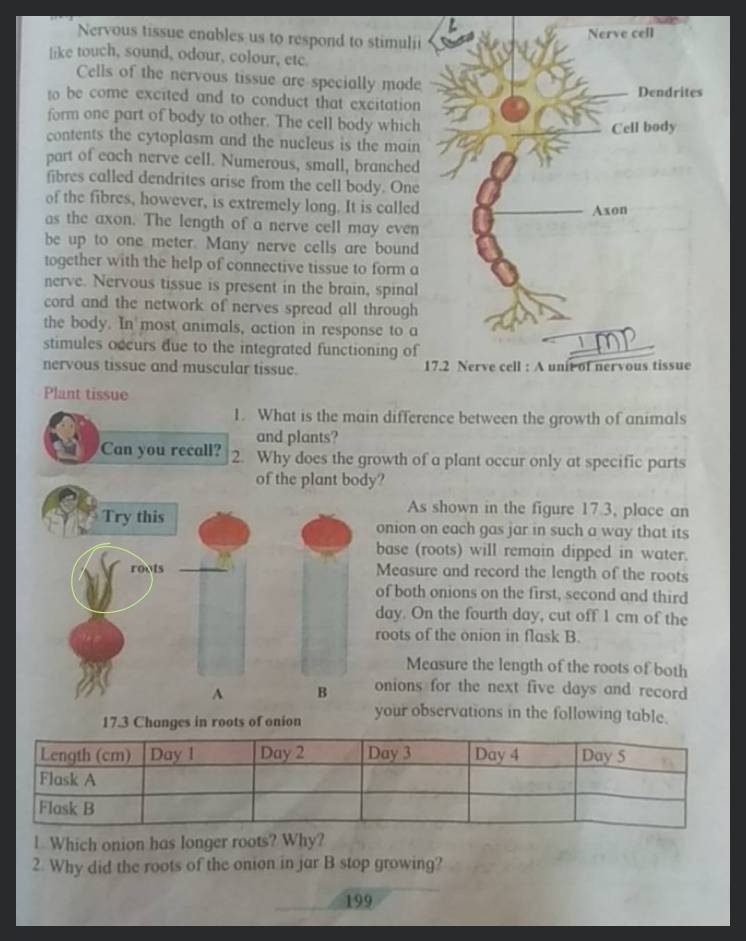Question
Question asked by Filo student

Nervous tissue enables us to respond to stimulii Nerve cell like touch, sound, odour, colour, etc Cells of the nervous tissue are specially mode to be come excited and to conduct that excitation Dendrites form one part of body to other. The cell body which contents the cytoplasm and the nucleus is the main Cell body part of each nerve cell. Numerous, small, branched fibres called dendrites arise from the cell body. One of the fibres, however, is extremely long. It is called as the axon. The length of a nerve cell may even be up to one meter. Many nerve cells are bound together with the help of connective tissue to form a nerve. Nervous tissue is present in the brain, spinal cord and the network of nerves spread all through the body. In'most animals, action in response to a stimules odeurs due to the integrated functioning of nervous tissue and muscular tissue. Plant tissue 1. What is the main difference between the growth of animals and plants? Can you recall? 2. Why does the growth of a plant occur only at specific parts of the plant body? As shown in the figure 17.3, place an onion on each gas jar in such a way that its base (roots) will remain dipped in water. Measure and record the length of the roots of both onions on the first, second and third day. On the fourth day, cut off of the roots of the onion in flask . Measure the length of the roots of both A B onions for the next five days and record 17.3 Changes in roots of onion your observations in the following table.
| Length | Day 1 | Day 2 | Day 3 | Day 4 | Day 5 |
|---|---|---|---|---|---|
| Flask A | |||||
| Flask B |
Found 6 tutors discussing this question
Discuss this question LIVE
10 mins ago

One destination to cover all your homework and assignment needs
Learn Practice Revision Succeed

Instant 1:1 help, 24x7
60, 000+ Expert tutors

Textbook solutions
Big idea maths, McGraw-Hill Education etc

Essay review
Get expert feedback on your essay

Schedule classes
High dosage tutoring from Dedicated 3 experts
Practice more questions on Biology
Question 1
Views: 5,205
Question 2
Hard
Views: 5,785
Question 3
Easy
Views: 5,754
Students who ask this question also asked
Question 3
Views: 5,847


Stuck on the question or explanation?
Connect with our Science tutors online and get step by step solution of this question.
231 students are taking LIVE classes
| Question Text | Nervous tissue enables us to respond to stimulii
Nerve cell like touch, sound, odour, colour, etc Cells of the nervous tissue are specially mode to be come excited and to conduct that excitation
Dendrites form one part of body to other. The cell body which contents the cytoplasm and the nucleus is the main Cell body part of each nerve cell. Numerous, small, branched fibres called dendrites arise from the cell body. One of the fibres, however, is extremely long. It is called as the axon. The length of a nerve cell may even be up to one meter. Many nerve cells are bound together with the help of connective tissue to form a nerve. Nervous tissue is present in the brain, spinal cord and the network of nerves spread all through the body. In'most animals, action in response to a stimules odeurs due to the integrated functioning of nervous tissue and muscular tissue.
Plant tissue
1. What is the main difference between the growth of animals and plants?
Can you recall? 2. Why does the growth of a plant occur only at specific parts of the plant body?
As shown in the figure 17.3, place an onion on each gas jar in such a way that its base (roots) will remain dipped in water. Measure and record the length of the roots of both onions on the first, second and third day. On the fourth day, cut off of the roots of the onion in flask .
Measure the length of the roots of both A B onions for the next five days and record 17.3 Changes in roots of onion your observations in the following table.
1. Which onion has longer roots? Why?
2. Why did the roots of the onion in jar B stop growing?
199 |
| Updated On | Mar 30, 2023 |
| Topic | Biology |
| Subject | Science |
| Class | Class 9 |
| Answer Type | Video solution: 1 |
| Upvotes | 78 |
| Avg. Video Duration | 7 min |




